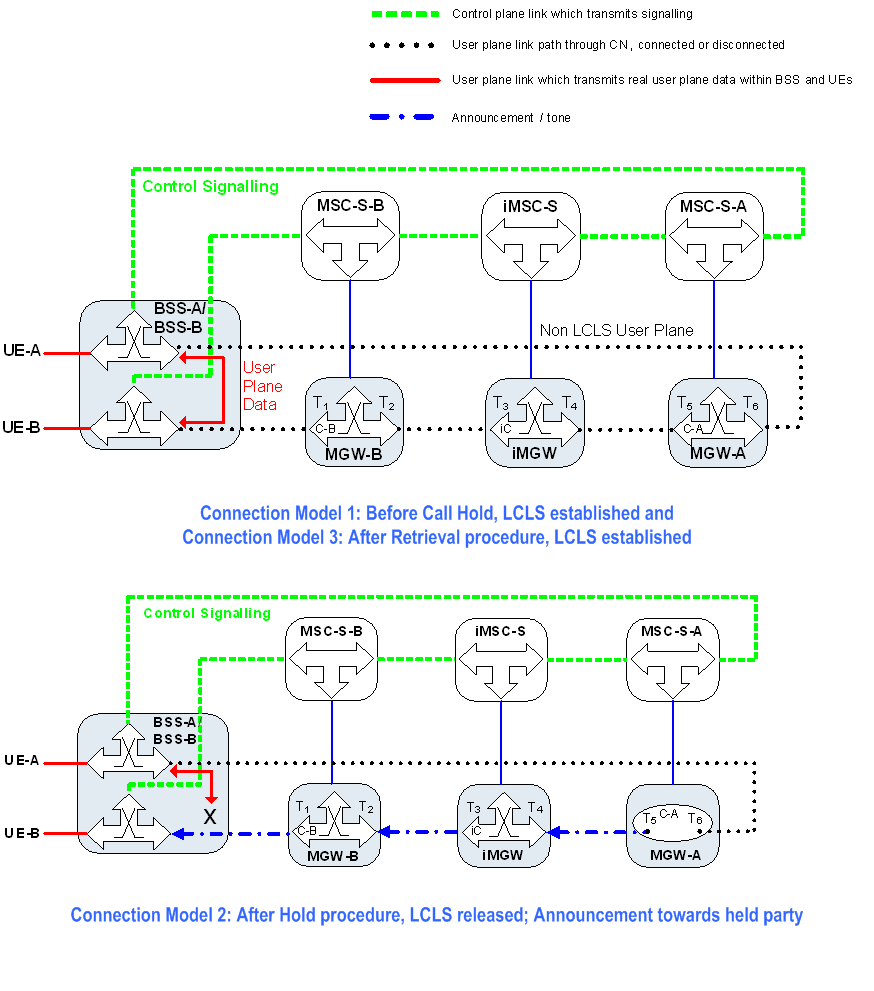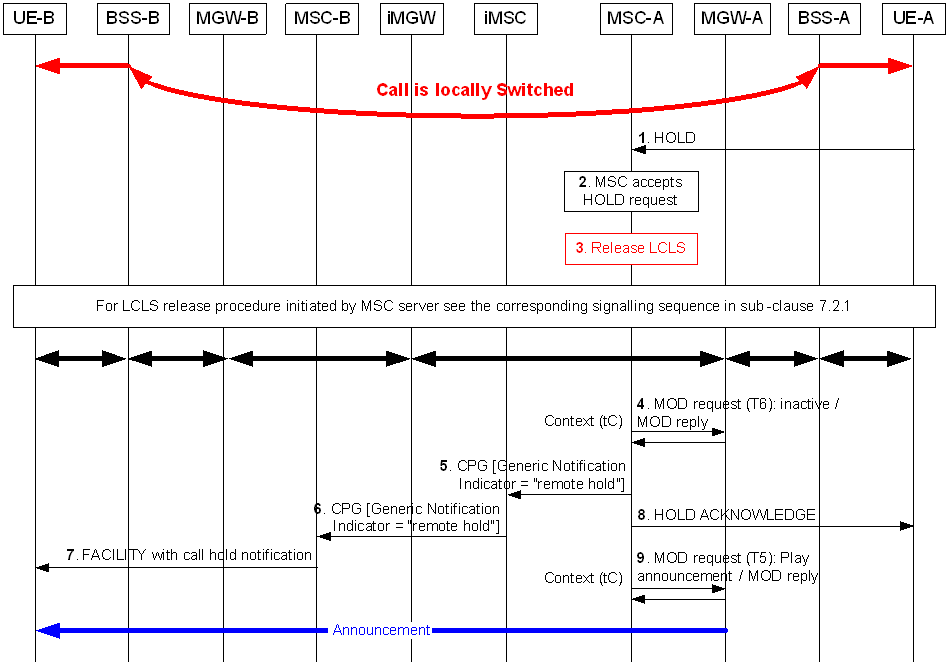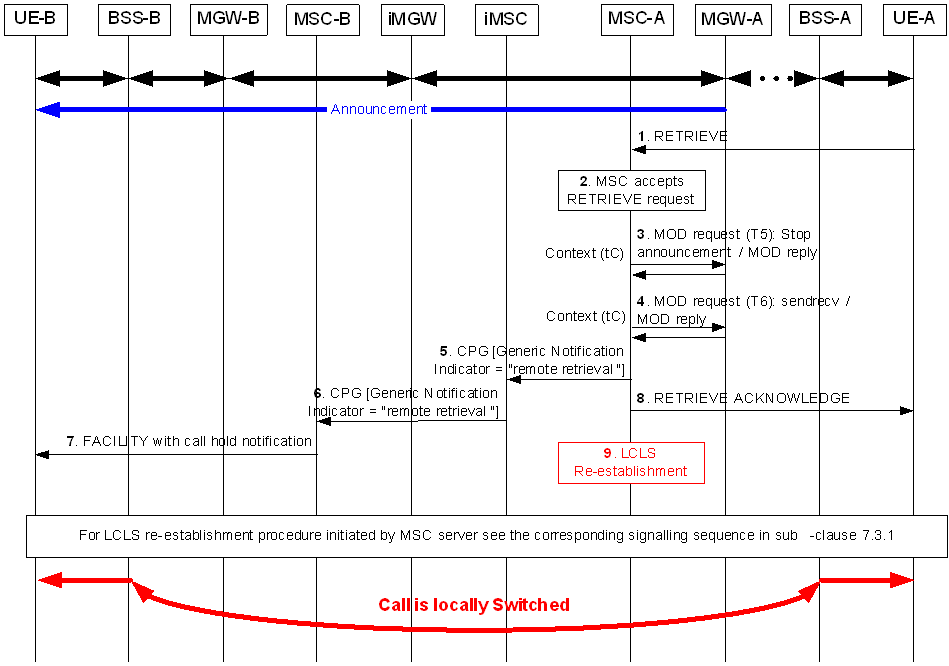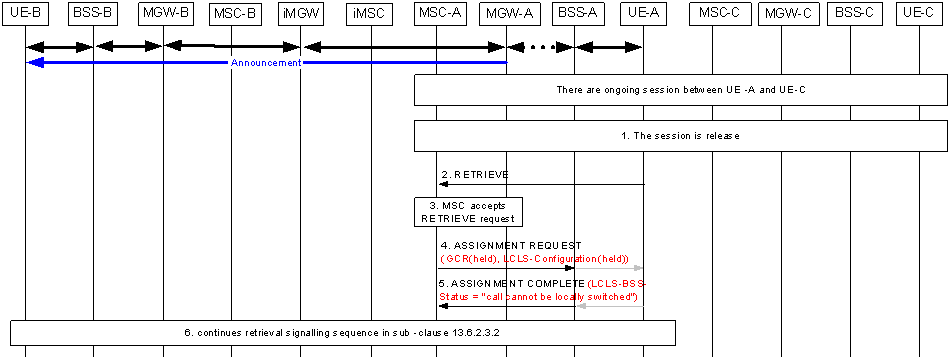Content for TS 23.284 Word version: 18.0.0
1…
4…
4.2…
4.3…
5
6…
6.3…
6.3.2
6.3.3
6.3.4
6.3.5
7…
7.2.4…
7.2.4.2
7.2.4.3
7.2.4.4
7.2.4.5
7.2.4.6
7.3…
7.3.4…
7.3.4.2
7.3.4.3
7.3.4.4
8…
8.2.3
8.3…
8.3.2
8.4…
8.4.1.1.7…
8.4.1.2…
8.4.2…
8.4.2.2…
8.4.5…
8.4.5.6
8.4.5.7
8.4.5.8…
9…
13…
13.4…
13.4.3…
13.4.4…
13.5…
13.6…
13.7…
14…
16…
A…
A.2…
13.6 Call Hold (CH)
13.6.1 Principles
13.6.2 Call Hold after Answer, LCLS established
13.6.2.3.1 Connection Model
13.6.2.3.2 Basic Sequence
13.6.3 Call Hold after Answer, LCLS not established
13.6.4 Establishment of a new call, the original call is hold
13.6.5 Retrieval of the held call, ongoing call is on-hold/completed
...
...
13.6 Call Hold (CH) p. 154
13.6.1 Principles p. 154
The procedures specified for the Call Hold supplementary service in clause 13.6 of TS 23.205 for BICC based CS Core Network and in clause 13.6 of TS 23.231 for SIP-I based CS Core Network shall be followed with the following modifications:
The following clauses describe the additional requirements related to the LCLS functionality when the Call Hold supplementary service is activated for the locally switched call.
13.6.2 Call Hold after Answer, LCLS established p. 154
13.6.2.1 Hold Request p. 154
When the UE makes a request for the hold function for the locally switched call the MSC server shall request a LCLS break procedure described in clause 7.2.1.
The MSC server shall request the MGW to interrupt the communication on the bearer by changing the through-connection of the bearer termination towards the served mobile subscriber to "inactive" or by using the Isolate Bearer Termination Procedure.
If an announcement is to be applied to the held party the MSC shall apply the procedure for non LCLS call defined in clause 14.6 of TS 23.205 for BICC based CS Core Network and in clause 14.6 of TS 23.231 for SIP-I based CS Core Network.
If a handover occurs to the UE making the request for the hold function (UE-A) while the party is not intended to be re-connected locally then the MSC Server shall include LCLS-Connection-Status-Control set to "do not establish LCLS" in the HO Request message.
13.6.2.2 Retrieval Request p. 154
When the UE makes a request to retrieve a held call the MSC server shall stop an announcement that was applied to the held party. The MSC shall request the MGW to re-establish communication to the held party by changing the through-connection of the bearer termination towards the served mobile subscriber to be both-way through-connected or by using the Join Bearer Termination Procedure.
If the call has been successfully negotiated for LCLS and an LCLS break was triggered by the CN the MSC server shall perform a LCLS re-establishment as described in clause 7.3.1.
13.6.2.3 Example p. 155
13.6.2.3.1 Connection Model p. 155
Figure 13.6.2.3.1.1 shows the network model for Call Hold supplementary service when LCLS was established. The MSC-B server seizes one context with two bearer terminations in the MGW-B. The bearer termination T1 is used for the bearer towards the BSS-B and the bearer termination T2 is used for the bearer towards the iMSC selected iMGW. The iMSC server seizes one context with two bearer terminations in the iMGW. The bearer termination T4 is used for the bearer towards the MSC-A server selected MGW-A and the bearer termination T3 is used for the bearer towards the preceding MGW-B. The MSC-A server seizes one context with two bearer terminations in the MGW-A. The bearer termination T5 is used for the bearer towards the iMSC selected iMGW and bearer termination T6 is used for the bearer towards the BSS-A.

13.6.2.3.2 Basic Sequence p. 156
Figure 13.6.2.3.2.1 shows the message sequence example for the Hold procedure with a possible notification to the held party using an announcement. In the example the MSC server requests the MGW to play an announcement towards the held party.

Step 1.
Figure 13.6.2.3.2.2 shows the message sequence for the Retrieval procedure.
HOLD message is received from the UE-A.
Step 2.
The MSC-A server accepts the HOLD request.
Step 3.
The MSC-A server requests a LCLS break procedure described in clause 7.2.1.
Step 4.
The MSC-A server requests the MGW-A to interrupt the communication on the bearer by changing the through-connection of the bearer termination towards the UE-A to "inactive".
Step 5.
The MSC-A server sends the CPG message with the Generic Notification Indicator parameter set to "remote hold" to the iMSC.
Step 6.
The iMSC server transfers the CPG message to the MSC-B server.
Step 7.
The MSC-B server sends FACILITY message with the call hold notification to the UE-B.
Step 8.
The MSC-A server informs the UE-A that call hold is accepted with the HOLD ACKNOWLEDGE message.
Step 9.
The MSC-A server requests the MGW-A to play an announcement towards the held party.

Step 1.
RETRIEVE message is received from the UE-A.
Step 2.
The MSC-A server accepts the RETRIEVE request.
Step 3.
The MSC-A server requests the MGW-A to stop an announcement towards the held party.
Step 4.
The MSC-A server requests the MGW-A to re-establish communication to the held party by changing the through-connection of the bearer termination towards the UE-A to be both-way through-connected.
Step 5.
The MSC-A server sends the CPG message with the Generic Notification Indicator parameter set to "remote retrieval" to the iMSC.
Step 6.
The iMSC server transfers the CPG message to the MSC-B server.
Step 7.
The MSC-B server sends FACILITY message with the call hold notification to the UE-B.
Step 8.
The MSC-A server informs the UE-A that retrieve request is accepted with the RETRIEVE ACKNOWLEDGE message.
Step 9.
If the call has been successfully negotiated for LCLS the MSC-A server requests a LCLS re-establishment procedure as described in clause 7.3.1.
13.6.3 Call Hold after Answer, LCLS not established p. 157
13.6.3.1 Hold Request p. 157
When the UE makes a request for the hold function for the non-local call the MSC server shall signal LCLS-CONNECT_CONTROL message with LCLS-Connection-status-control set to "do not establish LCLS".
13.6.3.2 Retrieval Request p. 158
When the UE makes a request to retrieve a held call the MSC server shall stop an announcement that was applied to the held party. The MSC shall request the MGW to re-establish communication to the held party by changing the through-connection of the bearer termination towards the served mobile subscriber to be both-way through-connected or by using the Join Bearer Termination Procedure.
If the call has been successfully negotiated for LCLS then MSC server shall signal LCLS-CONNECT_CONTROL message with LCLS-Connection-status-control set to "connect". If the BSS established local switching it shall notify the core network.
13.6.4 Establishment of a new call, the original call is hold p. 158
13.6.4.1 General Principle p. 158
The call hold procedures and call establishment procedures shall be applied with the following enhancements.
To avoid the local switching between remote parties of the new call and the held call, the new call shall have a different GCR than the GCR of the original call. During the new call establishment, the MSC server serving the UE which has the held call and has initiated the new call shall generate a new GCR for the new call.
The MSC server shall use the ASSIGNMENT REQUEST message to update the BSS serving the UE which has the held call and has initiated the new call with the new GCR and LCLS-Configuration for the new call.
The access bearer is kept unchanged.
13.6.4.2 Assignment Request p. 158
During the new call establishment, the MSC server serving the UE which has the held call and has initiated the new call shall send the Assignment Request message to update the BSS with the new GCR and LCLS-Configuration for the new call.
On receipt of Assignment Request, the BSS shall save the GCR and LCLS-Configuration in this message.
13.6.5 Retrieval of the held call, ongoing call is on-hold/completed p. 158
13.6.5.1 General Principle p. 158
When the UE requests to place the new call on hold and retrieve the original call, the MSC server shall initiate normal call hold procedures as described in clause 13.6.1 for the new call. The MSC server sends the ASSIGNMENT REQUEST message with the GCR and LCLS-Configuration of the original call to the BSS. The MSC server continues the retrieval procedure as described in clause 13.6.2.2.
When the UE requests to retrieve the original call after the active session has completed, the MSC server shall send the ASSIGMENT REQUEST message to the BSS to update the GCR and LCLS-Configuration for the original call. The MSC server continues the retrieval procedures as described in clause 13.6.2.2.
13.6.5.2 Example call flow, Retrieval of held call after ongoing call has completed p. 159

Figure 13.6.5.2.1: Retrieval of held call, ongoing call has completed
(⇒ copy of original 3GPP image)
(⇒ copy of original 3GPP image)
Step 1.
The active session between UE-A and UE-C is released.
Step 2.
The RETRIEVE message is sent from UE-A to MSC-A Server.
Step 3.
MSC-A server accepts the RETRIEVE request.
Step 4.
MSC-A server retrieves the LCLS-Configuration and GCR for the held session and sends the ASSIGNMENT REQUEST message to BSS-A including the LCLS-Configuration IE and the GCR IE.
Step 5.
The BSS-A returns the ASSIGNMENT COMPLETE message with the LCLS-BSS-Status IE indicating "call not possible to be locally switched".
Step 6.
MSC-A server continues the sequence handling described in clause 13.6.2.3.2.